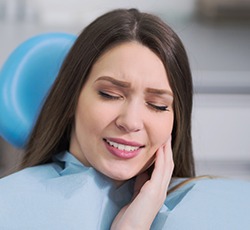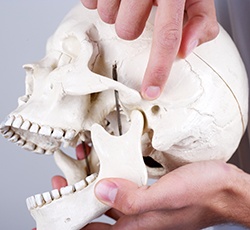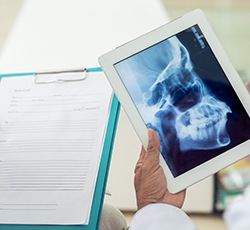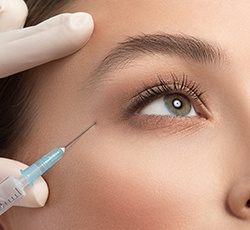
TMD & Bruxism Therapy in Lovell
Protect Your Smile From Pain
Temporomandibular joint disorder, or TMD, affects approximately 5 to 12% of the American population, causing a variety of symptoms that substantially interfere with daily life in more ways than one. Associated with chronic jaw pain, difficulty chewing, and frequent migraines, TMD is second only to lower back pain as the most common musculoskeletal condition that causes disability. Many patients who suffer from TMD are also affected by nighttime teeth grinding, or bruxism.
At Lovell Dental, we believe that everyone should enjoy a healthy, pain-free life, and that’s why Dr. Anderson offers TMD therapy and bruxism treatment for patients suffering from these and other related symptoms.
What Causes TMD?

TMD is typically caused by a number of factors affecting either the temporomandibular joint (TMJ), the muscles that control it, or a combination of the two.
Problems within the joint itself include:

- Injury – Trauma to the TMJ or the cartilage disc that lies between the bones can lead to chronic pain.
- Arthritis – Some forms of arthritis, including gout and rheumatoid arthritis, can cause inflammation of the jaw joints.
- Wear and tear – When the cartilage disc inside the TMJ becomes worn with age, persistent pain can result.
Issues may be caused by:

- Muscle strain or excessive activity – Individuals who clench their jaw tightly during sleep often suffer from disorders of the temporomandibular joint.
- Increased pain sensitivity – While there is no clear indication as to why this occurs in some patients, it is a common problem. Many believe that stress plays a role in a patient’s level of sensitivity to pain, as do conditions like fibromyalgia.
The Importance of Treating Bruxism & TMD

When TMD is left untreated, the wear and tear of the joint continues, further exacerbating the pain. The continued strain on the muscles may even visibly alter the appearance of the face’s shape over time. While early TMD treatment is non-invasive and relatively simple in nature, advanced cases may call for surgical correction of the jaw joints. In the case of bruxism, the teeth are at risk for severe damage if the condition is not addressed in a timely manner. The extensive force of the grinding causes teeth to gradually wear down, causing them to appear shorter and flatter. The teeth may even fracture, leading to pain and a need for immediate repair. A nightguard, also known as an oral splint, can be worn to prevent teeth grinding while the patient sleeps.
BOTOX® for Jaw Tension, Bruxism & TMD Pain

BOTOX® is a safe and effective treatment option for patients experiencing facial pain due to TMD. When injected into the frontalis, temporalis, and masseter muscles, BOTOX® can relieve chronic headaches as well as the tension and discomfort associated with jaw clenching. The procedure is relatively quick, and most patients experience dramatic pain relief within just a few short days. Dr. Anderson has completed advanced continuing education courses from the American Academy of Facial Esthetics, specializing in BOTOX® therapy for the treatment of TMD.
Learn More About Botox for TMD Therapy
Schedule Your Consultation Today

If you experience frequent headaches, jaw pain, facial tension, aching muscles in the neck and back, or any of the other symptoms of TMD and bruxism, Dr. Anderson can help. Contact us today to schedule your consultation and discover real TMD pain relief that allows you to enjoy an improved quality of life every day.
Our state-of-the-art dental practice in Lovell warmly welcomes patients from throughout the surrounding areas, including Cowley, Basin, Greybull, Deaver, Powell, Cody, Byron, Burlington, Frannie, Manderson, and beyond.
TMJ Treatment FAQs
Can TMJ Be Treated Without Surgery?
Most TMJ disorders can be treated without surgery, and the National Institutes of Health generally recommends the least invasive methods possible. At Lovell Dental, we take a conservative approach, focusing on gentle treatments to relieve pain and restore quality of life. Common options include:
- Custom oral splints or nightguards
- Physical therapy and jaw exercises
- Lifestyle changes like stress management
- BOTOX injections to relax tense jaw muscles
We tailor every treatment plan to your specific symptoms and goals. If your TMJ issues persist or worsen, we’ll refer you to a specialist for advanced care, but surgery is usually a last resort.
Is BOTOX for TMJ Safe?
Yes, BOTOX is generally considered safe and effective for TMJ treatment when administered by a trained professional like Dr. Anderson. At our Lovell dental office, we use it to relax the overactive jaw muscles that cause tension, pain, and teeth grinding. This grants relief from TMJ pain and helps keep the jaw muscles from becoming overactive for the duration of the treatment.
That being said, there are some possible rare, mild, and temporary side effects. These may include:
- Minor bruising at the injection site
- Temporary jaw weakness
- Headaches or flu-like symptoms
Overall, BOTOX offers a non-surgical, low-risk option for managing TMJ symptoms. If you’re concerned about your treatment, we’ll walk you through everything during your consultation.
How Long Does It Take for BOTOX Injections to Work for TMJ?
Most patients begin noticing relief from TMJ symptoms within three to five days after receiving BOTOX injections. However, full effects typically take about one to two weeks to develop.
We carefully target the right jaw muscles to help reduce clenching, tension, and discomfort. The effects of BOTOX usually last between three and four months, but this can vary based on factors like the severity of your condition and genetics.
If you’re tired of jaw pain or headaches caused by TMJ, BOTOX might be a quick and easy solution that fits your lifestyle.
How Long Does It Take for a TMJ Splint to Work?
TMJ splints, also called nightguards, can start relieving pain within just a few days of wearing them, but full results often take a few weeks to a few months. These custom oral appliances help reduce teeth grinding and clenching, reposition your jaw for better alignment, and ease muscle tension as you sleep.
This leads to less pain in your jaw when you wake up and possibly more energy overall. With regular use and good oral care, a TMJ splint can significantly reduce discomfort and prevent further joint damage. Patience is key, but relief is well within reach!